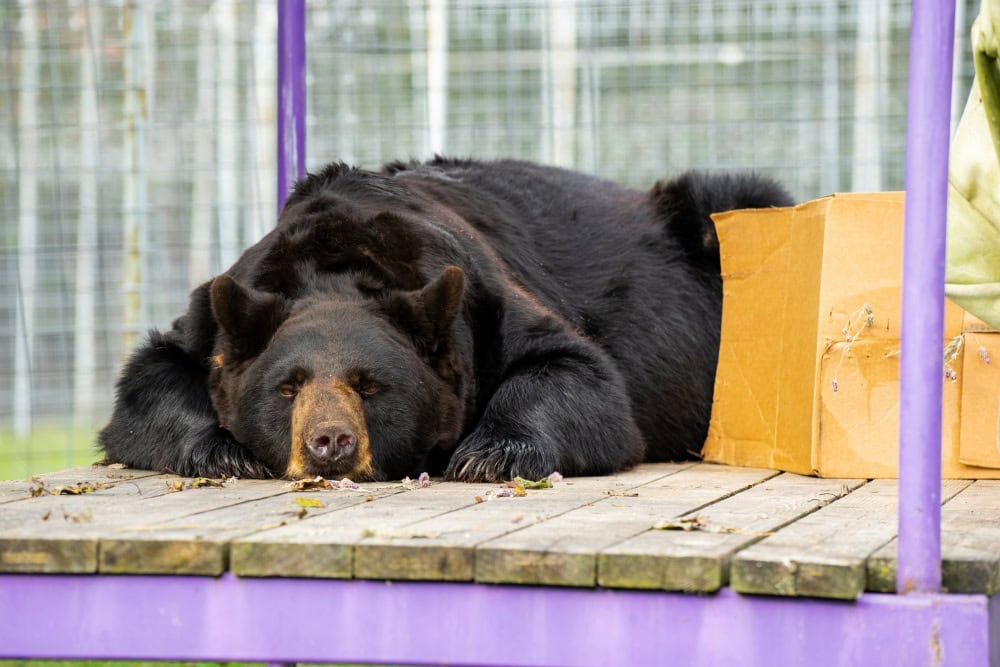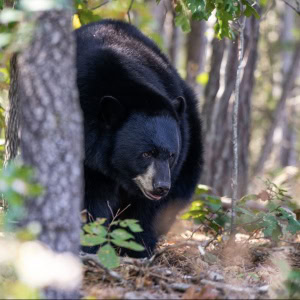
Taxonomy
Kingdom: Animalia
Phylum: Chordata
Class: Mammalia
Order: Carnivora
Family: Ursidae
Genus: Ursus
Species: americanus
Scientific Name: Ursus americanus
IUCN Red List of Threatened Species Status: Least Concern
About
Habitat: Black bears require large areas of diverse habitats to thrive. They are typically found in heavily wooded areas. These areas include large tracts of forest with little human disturbance. The amount of resources available greatly influences Their habitats. Other habitat types include brackish and freshwater marshes, salt domes, wooded spoil levees along canals and bayous, and agricultural fields.

Territoriality: Black bears are solitary animals and roam a vast area of territory; But, they do not protect their territory from other bears. Black bears can wander a 15-80 square mile home range. Their natural home range is solely dependent on food abundance, location, and the season of the area.
Lifespan
In the Wild: 15-25 years
In Captivity: 30-35 years
Population
Predicted to have 850,000-950,000 in North America, the majority of those are found in the United States and Canada. There is no estimate for black bear populations in Mexico.
Physical Description
Weight: 200-600 pounds (depends on sex, age, and season)
Length: 5 to 6 feet
Black bears are the most common bear in North America. They do not have to be black, but range in coat coloration depending on where they reside. Their fur can range from blonde to brown, red to black, and even white. Eastern populations are mostly black, Western populations have brown, cinnamon, and blond coloration and a white population of black bear exists primarily in coastal British Columbia.

Fun Facts
- Bears run as fast as a horse, up to 30 mph, both uphill and downhill.
- Black bears are great climbers and can quickly scale a tree.
- They can smell 2,100 times better than a human, and also have excellent hearing and sight.
- Every bear defends its territory, and that space depends on the bear and the situation.
- A mother bear will always protect their cubs and may chase them up a tree and protect them from the bottom of the tree. Females are easily provoked when defending cubs.
History
When Europeans began settling in North America during the 1900s, black bear populations reached an extreme low due to overhunting. The creation of state and provincial protection allowed these populations to start recovering. The late 1980s saw rapid growth in species numbers, due to their protection. Before the dawn of the new century, black bear populations seemed to be stable.
Arkansas was unofficially called the “Bear State” during the 19th century. However, during this period, bears were highly sought after for their fat. Household items using it prominently, such as soap, candles, hair products, insect repellent, and oil lamps. Their fat created more value than their meat and hide, as it was multi-purpose. The demand for all parts of a bear increased hunting, resulting in the overexploitation of the animal. At that time, hunters and trappers could sell pelts for $2, oil for $1 a gallon, and meat for $10 per 100 pounds; one dollar in the early 1900s equals almost $30 in today’s market. By overhunting, the bears were brought to the brink of extirpation, or removed entirely, in Arkansas. 1927 saw the closing of hunting seasons with an estimated 25-50 black bears remaining.
The Arkansas Game and Fish Commission began a bear restoration program in 1958. Within ten years, this program translocated 254 bears from Minnesota and Manitoba, Canada, to the Ozark and Ouachita National Forests of Arkansas. Over 5,000 black bears now call Arkansas home. The restoration of black bears in Arkansas serves as one of the most successful reintroductions of a large carnivore into a previously inhabited area.
Reproduction
Gestation Period: 220 days
Litter size: 1 to 4 cubs (2 average)
A female bear comes into sexual maturity at three years old. Mating occurs in the summer, and an embryo does not get implanted until late fall when they start entering their winter dens. This variation of reproduction is called delayed implantation, and it is reliant on the number of resources available to the animal. If a female bear cannot store enough fat during the year to ensure the future survival of herself and her cub(s), the embryo will not attach, and the bear will not become pregnant. An embryo will implant if food sources are plentiful, and the female will give birth. Females can have a new litter of cubs every other year. Through delayed implantation, females can increase the chance of survival not only for themselves but also for their cub(s).
A female black bear is incredibly protective of her cubs and will raise them until they reach the age of two. The cubs will stay with the mother through their second winter and, in the following spring, will move away from their mother to lead solitary lives as adults.
Diet and Hunting Behaviors
![]()
Black bears are omnivorous, eating plants and animals; their diets consist of approximately 90% plant-based materials and 10% protein. They are also opportunistic, eating whatever is most readily available in their habitats. Bears have an incredible sense of smell, 2,100 times stronger than humans. They use this sense for foraging or finding food. Bears forage for many plants like grasses, roots, and berries. They have also been known to eat small insects. Bears are large predators able to scavenge for carrion, but records show they can hunt down juvenile ungulates, like deer and moose successfully.
Their diets will ultimately depend on the time of year. In early spring, bears are just beginning to emerge from their winter dens. They tend to look for roots, insects, and grasses to cleanse out their digestive systems after the long winter. This time is called the negative foraging period. In the fall, bears are starting to eat lots of higher-fat foods, like nuts, to gain weight for the winter.
While bears will typically avoid people, there are some cases of bears looking for easy meals in dumpsters or garbage cans. Once a bear finds a food source that is easy to acquire, they will continue to use it, even if that means coming near humans. To prevent human-bear conflicts, it is imperative to ensure you are taking safety precautions to help keep yourself and wildlife safe. For more information about bear safety, check out our Bear Safety blog.
Bears Are Not True Hibernators
People may call a bear’s winter sleep a variety of things, depending on the person. These names can include shallow torpor, dormancy, hibernation, or winter lethargy. During this time of inactivity, the bear’s heart rate decreases, its metabolic and breathing rates will slow down, and its body temperature will drop. But when it comes to bears, they are too large to go into a state of true hibernation. Their body temperature will only lower by about 10°F; smaller mammals who will exhibit true hibernation will drop their body temperatures by about 60°F.
Black bears are adapted to survive inactivity for up to five months in the winter. While inside their winter dens, they do not consume food or emit waste. A bear’s body will change, to prevent their bodies from poisoning themselves with all of their waste so that their kidneys can process this waste. Because they do not eat after entering their den, they lose about 10 to 15 percent of their body weight. If a human were to stay in bed for five months, they would lose lots of muscle mass; a bear’s body is hardwired to prevent this from happening. They will experience micromovements throughout their winter denning to avoid atrophy, or muscles wasting away. They are also able to process urea, a component of urine, to build new proteins and help to maintain their muscle and organ tissue.
Threats and Conservation
Throughout most of North America, the IUCN Redlist does not consider American black bear populations severely threatened. There are a few isolated populations on the verge of becoming extirpated, locally extinct, due to dwindling population numbers, lack of food and water resources, or human-bear conflict. However, across the United States and Canada, there are well-regulated hunting seasons and responsible programs to manage bear populations. The most significant threat to black bears is human-bear conflict. This conflict stems from a bear’s opportunistic food habits. Black bears are incredibly curious about many human food sources like garbage, crops, and livestock, especially when their natural food sources are scarce. This interest can lead to bears and humans competing for the same space, increasing the likelihood of curious bears being terminated. For information on how to limit conflict between humans and bears, check out our Bear Safety Blog!